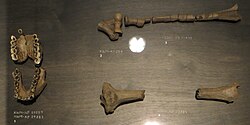Australopithecus anamensis
| Australopithecus anamensis Temporal range: Pliocene | |
|---|---|
 | |
| Fossils | |
| Scientific classification | |
| Kingdom: | |
| Phylum: | |
| Class: | |
| Order: | |
| Family: | |
| Subfamily: | |
| Genus: | |
| Binomial name | |
| Australopithecus anamensis Leakey et al., 1995 | |
Australopithecus anamensis is a species of Australopithecus.[1]
Fossils
[change | change source]First specimen
[change | change source]The first fossilized specimen of the species, though not recognized as such at the time, was a single arm bone. It was found in Pliocene strata in the Kanapoi region of East Lake Turkana by a Harvard University research team in 1965. The specimen was tentatively assigned at the time to Australopithecus and dated about four million years old.
1987 specimen
[change | change source]Little additional information was uncovered until 1987, when Canadian archaeologist Allan Morton (with Harvard University's Koobi Fora Field School) discovered fragments of a specimen sticking out of a hillside east of Allia Bay, near Lake Turkana, Kenya.
Allia Bay site
[change | change source]Six years later the London-born Kenyan paleoanthropologist Meave Leakey and archaeologist Alan Walker excavated the Allia Bay site and uncovered several additional fragments of the hominid, including one complete lower jaw bone which closely resembles that of a common chimpanzee (Pan troglodytes) but whose teeth are much more similar to those of a human. In 1995, Meave Leakey and her associates, taking note of differences between Australopithecus afarensis and the new finds, assigned them to a new species, A. anamensis, deriving its name from the Turkana word anam, meaning "lake".
References
[change | change source]- ↑ Gosh, Pallab 2019. 'All bets now off' on which ape was humanity's ancestor. BBC News Science & Environment.
